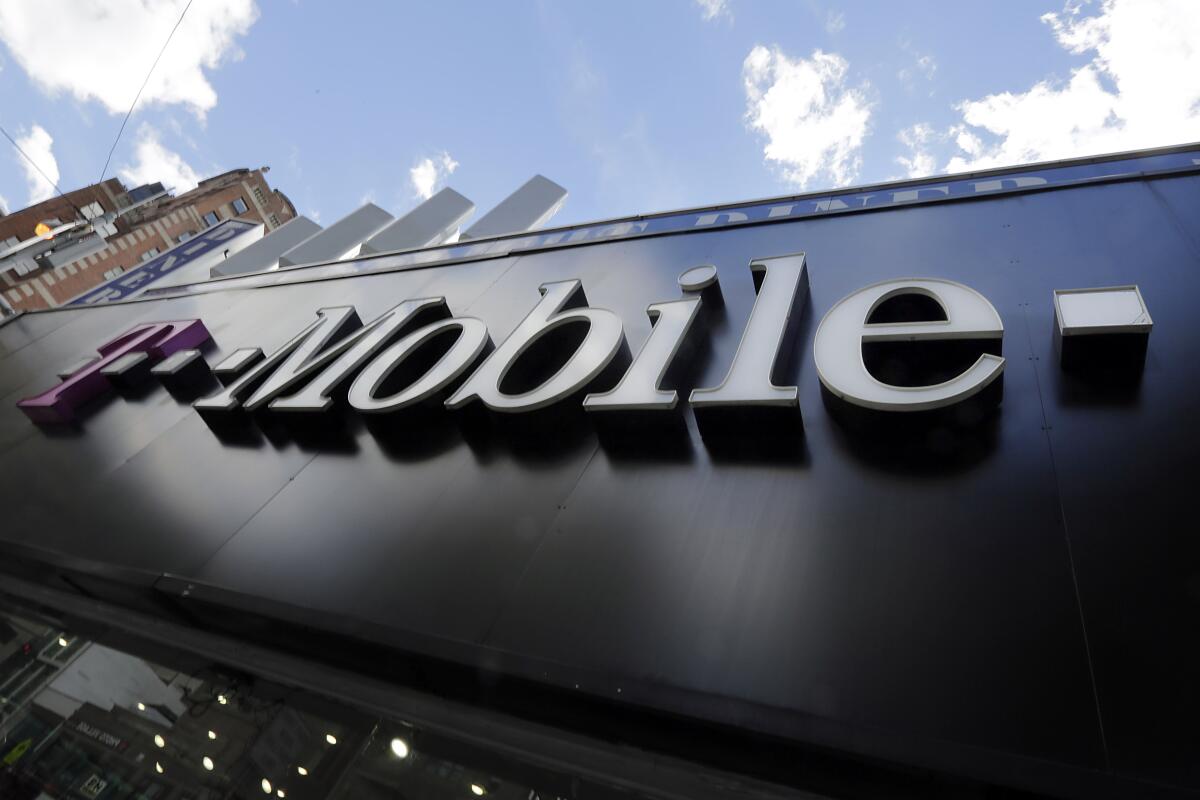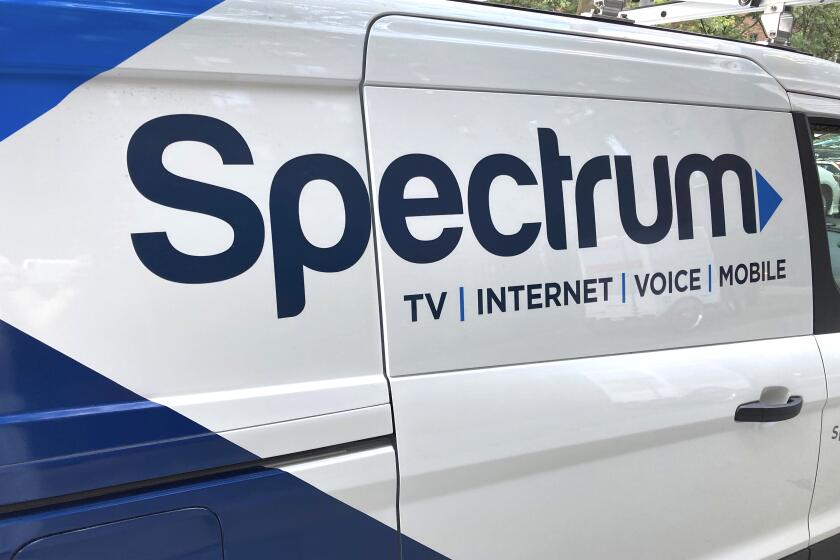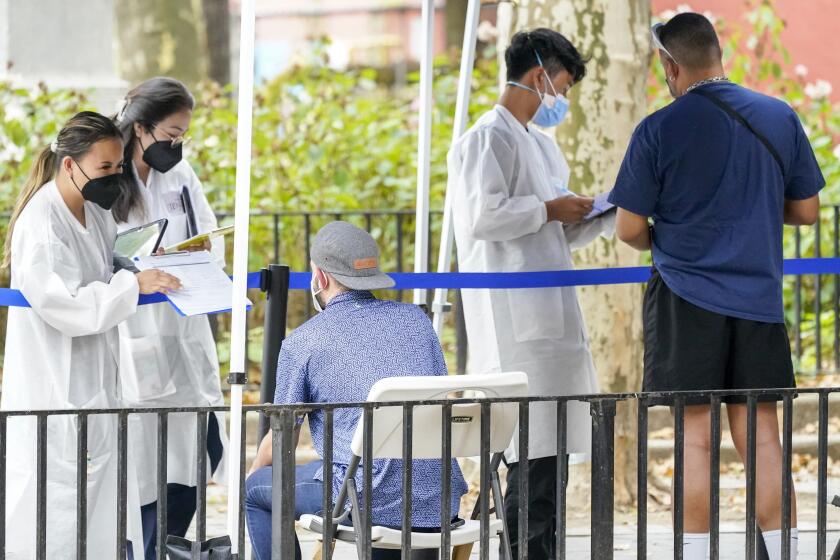If you get free phone or internet in California, watch out for this snag

- Share via
Rick, a learning disabled retiree, was at his Los Angeles apartment last month when a salesperson from Assurance Wireless stopped by to offer a free mobile phone account, complete with a free phone.
The next thing he knew, Rick had lost the $30-a-month discount he’d been getting on his broadband account with Spectrum, a completely different company.
For the record:
11:25 a.m. Aug. 12, 2022An earlier version of this story stated that, according to Danielle Perry of TruConnect, federal rules require ACP recipients to be notified within five days of their account being terminated. Perry said the rules require notice to be given within five days of an ACP subsidy being transferred to a different carrier.
The story also stated that the ACP subsidy could be used to pay for a mobile phone along with mobile data. It can pay only for internet service, either wired or wireless.
This is just the sort of nasty surprise that lower-income people have experienced not only in California, but across the United States. Researchers have found that salespeople offering the free phone service, known in California as LifeLine, often leave consumers in the dark about the trade-offs that come with it.
In particular, each household can have only one account subsidized by LifeLine, and they can have only one supported by the Affordable Connectivity Program, which enables lower-income people to get free or deeply discounted broadband service. Free mobile internet service can be funded by either LifeLine or ACP, so you have to be careful to understand which one’s at issue if you sign up.
Rick’s brother Dave (who asked that their last names not be used to protect Rick’s privacy and prevent him from becoming a target for scammers) is an actuary in Santa Barbara, and he was able to undo the damage. But Dave said he wonders how many times this sort of thing has happened to consumers who don’t have financially savvy people looking after their interests.
The answer, consumer advocates say, is probably a lot, even though there are safeguards designed to prevent it from happening at all.
More Southern California internet providers are on board with the federal subsidy. But signups still lag. Here’s how to get free broadband service.
Aggressive sales tactics
The questionable tactics employed by some LifeLine companies around the country prompted the Federal Communications Commission’s Office of Inspector General to issue a consumer advisory in March. Some (unnamed) companies that offered both LifeLine and ACP services were misleading customers into applying for unwanted ACP subsidies or transferring their existing subsidies to LifeLine service, the OIG warned.
“Customers who do not carefully review the online process may find themselves enrolled in ACP or have their ACP service transferred away from their preferred provider when they seek [LifeLine] service from one of the providers employing these tactics,” the advisory states.
The ACP subsidy enables many Southern Californians to obtain a broadband connection to their home computer, game console and smart TV sets at no charge. Without the subsidy, they’d have to pay full price for that bandwidth.
According to a study of the LifeLine program by Cal State Sacramento in May, “street teams” of salespeople account for about 70% of the customers signed up for wireless LifeLine service. These groups may pitch LifeLine’s free phone service door to door, but more typically operate out of informal pop-up shops near government offices or high-traffic urban areas, often in lower-income neighborhoods.
“Most focus group participants describe not actively seeking a free or discounted phone, rather encountering a Street Team when exiting a benefits office and learning they were eligible for LifeLine,” the report says.
The study found “highly prevalent” reports of salespeople “not fully disclosing program requirements to customers that resulted in positive outcomes for Street Team members and negative impacts to customers.” For example, the study said, street teams may not tell customers about the “one household rule,” so they could later lose their service because someone else in their household already had LifeLine.
According to his brother Dave, Rick had a mobile phone as part of his brother’s family plan. But in mid-July, a saleswoman came to his apartment with a free new phone that he hadn’t asked for and didn’t need.
“She insisted on setting it up, and left him with the phone and some paperwork that she filled out (he did not sign anything),” Dave said in an email. “He tried to follow her as she left to give her back the phone, but she would not take it and told him to just give it to a friend.”
That’s how Rick was enrolled in Assurance Wireless, which is T-Mobile’s LifeLine service. And unbeknownst to him, Assurance used Rick’s $30-a-month federal ACP subsidy instead of using the roughly $25 a month in state and federal LifeLine subsidies to pay for the service. As a result, he lost the subsidy he’d been receiving on his Spectrum broadband service.
Who is eligible to get the monkeypox vaccination in Los Angeles right now? And how to do you get one? Here’s what to know.
Under federal rules, providers are required to disclose the one-per-household limit on ACP and get customers to sign off when their subsidy is being switched, said Danielle Perry, chief compliance officer for wireless provider TruConnect and a board member of the National Lifeline Assn. But Dave said his brother insists that he wasn’t told about the change and that he didn’t sign anything.
One other safeguard, Perry said, is that broadband providers have to notify customers within five days when their ACP subsidy has been switched to a different carrier. That’s how Dave found out about his brother’s situation — he got a note from Spectrum. That led to a series of discussions with Spectrum and Assurance, Dave said, culminating in the cancelation of Rick’s new phone line and the restoration of his broadband discount.
T-Mobile did not respond to requests for comment.
Paul Goodman, an attorney for the Center for Accessible Technology in Berkeley, said this sort of issue has plagued LifeLine subscribers for years. Back when landline phone service was ubiquitous, salespeople were signing up LifeLine customers for wireless phones without telling them that they’d lose their subsidized home phone line, Goodman said.
Street teams are typically contractors, Goodman said, and their employees have a financial incentive to sign up as many customers as they can (a point the Cal State Sacramento study makes as well). If they’re selling services subsidized by ACP, however, federal rules do not allow them to be paid commissions, Perry said.
One benefit of the street teams, the Cal State Sacramento report says, is that they enable low-income people to get a mobile phone and service on the spot. But Ashley L. Salas, a telecommunications attorney with consumer advocacy group the Utility Reform Network, said the use of street teams has been a main concern for consumer advocates because they don’t provide enough information for people to make informed decisions.
Media company E.W. Scripps has launched an education campaign to promote the use of over-the-air antennas to get broadcast signals.
To bundle or not to bundle
Consumers can have a LifeLine wireless phone and an ACP-subsidized broadband line, Salas said, but the two cannot be bundled into one package. It’s not clear why Assurance Wireless hijacked Rick’s ACP subsidy for mobile phone and data service, but it is more lucrative than the combined state and federal LifeLine amounts.
Many of the companies providing LifeLine phone service are pushing the California Public Utilities Commission to change its rules and allow them to offer mobile phone and data plans financed by all three subsidies — state and federal LifeLine dollars and federal ACP funds. A number of other states allow this kind of bundling, and California allowed a similar bundle last year with subsidies from the federal Emergency Broadband Benefit program. The state stopped that practice when the ACP launched early this year.
The commission staff opposes the idea, as do TURN and the Center for Accessible Technology. Goodman said the wireless companies haven’t offered proof that the additional money is needed to provide better service.
Perry countered that allowing customers to devote all their subsidies to mobile broadband would enable carriers to provide better bandwidth and better devices. Many of the complaints that the Cal State Sacramento researchers heard from LifeLine customers stemmed from the quality of the free phones offered by LifeLine services.
A large percentage of TruConnect’s customers are homeless or highly mobile, Perry said, and it should be up to consumers, not the state, to decide what broadband plan works best for them. The Public Utilities Commission is expected to rule on the issue at its meeting Aug. 25.
Despite the street teams’ tactics, there remains a yawning gap between the number of Californians eligible for LifeLife subsidies and the number who use them. According to the Cal State Sacramento study, only 30% of eligible Californians have LifeLine service.
Similarly, ACP subsidies reach a low percentage of the Californians who qualify for them: 28% statewide and 32% in L.A. County.
Here are the details of CalKIDS, which automatically creates a college savings plan for newborn Californians and offers up to $1,500 for low-income kids in primary and secondary school.
Where to take a complaint
If you experience a problem with LifeLine or ACP, help is available from the California Public Utilities Commission and the FCC:
- The FCC’s ACP Helpline can be reached at (877) 384-2575, with guidance in English and Spanish. For video calls in American Sign Language, call (844) 432-2275, For help online, go to the FCC site.
- The FCC’s Office of Inspector General has a hotline: (202) 418-0473 or (888) 863-2244. You can email the OIG at [email protected] or fax it at (202) 418-2811.
- The California Public Utilities Commission has a LifeLine Call Center to answer questions and offer assistance with the program, with support available in 10 languages and via TTY. The main number is (866) 272-0357, which can also transfer you to lines in languages other than English.
- To file a complaint about sales tactics or other issues related to LifeLine, you can do so with the Public Utilities Commission’s Consumer Affairs Branch by phone at (800) 649-7570 or fax at (415) 703-1158; by filing a form online; or by sending a letter to the California Public Utilities Commission Consumer Affairs Branch, 505 Van Ness Ave., San Francisco, CA 94102-3298.
About The Times Utility Journalism Team
This article is from The Times’ Utility Journalism Team. Our mission is to be essential to the lives of Southern Californians by publishing information that solves problems, answers questions and helps with decision making. We serve audiences in and around Los Angeles — including current Times subscribers and diverse communities that haven’t historically had their needs met by our coverage.
How can we be useful to you and your community? Email utility (at) latimes.com or one of our journalists: Jon Healey, Ada Tseng, Jessica Roy and Karen Garcia.











